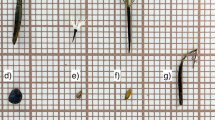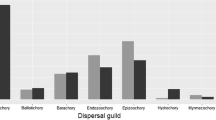Abstract
Primary and secondary seed dispersal was investigated for the glacier lily Erythronium grandiflorum in the Colorado Rocky Mountains. These heavy seeds have no obvious adaptations for biotic or abiotic dispersal, but can be thrown short distances when the dehiscent fruits are shaken by wind. We used sticky traps to measure primary transport of seeds up to 1 m away from individual plants. A seed cafeteria experiment examined the role of ants and rodents in secondary seed transport. Primary dispersal by wind was positively skewed and median transport distances were influenced by variation in plant height. Secondary dispersal was negligible compared to Viola nuttallii, an elaiosome-bearing species. Thus, seed dispersal was highly restricted in E. grandiflorum, and a 1 m radius encompassed the modal section of the seed dispersal curve. The seed dispersal component of gene flow was quantified and combined with previous measurements of pollen flow to yield a more complete estimate of Wright's neighborhood size, N e, for E. grandiflorum. The lack of a special seed dispersal mechanism in E. grandiflorum is discussed in terms of a source-sink model for seedling establishment with respect to distance from the parental plants.
Similar content being viewed by others
References
Andersen MC (1993) Diaspore morphology and seed dispersal in several wind-dispersed Asteraceae. Am J Bot 80: 487–492
Augspurger CK (1986) Morphology and dispersal potential of wind-dispersed diaspores of neotropical trees. Am J Bot 73: 353–363
Beattie AJ, Lyons N (1975) Seed dispersal in Viola (Violaceae): adaptations and strategies. Am J Bot 62: 714–722
Beattie AJ, Culver DC (1979) Neighborhood size in Viola. Evolution 33: 1226–1229
Beattie AJ, Culver DC (1983) The nest chemistry of two seed-dispersing ant species. Oecologia 56: 99–103
Burrows FM (1986) The aerial motion of seeds, fruits, spores and pollen. In: Murray DR (ed) Seed dispersal. Academic Press Australia, North Ryde, pp 1–47
Casper BB (1987) Spatial patterns of seed dispersal and postidispersal seed predation of Cryptantha flava (Boraginaceae). Am J Bot 74: 1646–1655
Crawford TJ (1984a) The estimation of neighbourhood parameters for plant populations. Heredity 52: 273–283
Crawford TJ (1984b) What is a population? In: Shorrocks B (ed) Evolutionary ecology. Blackwell, Oxford, pp 135–174
Cruzan MB (1990) Pollen-pollen and pollen-style interactions during pollen tube growth in Erythronium grandiflorum (Liliaceae). Am J Bot 77: 116–122
Eguiarte LE, Burquez A, Rodriguez J, Martinez-Ramos M, Sarukhan J, Pinero D (1993) Direct and indirect estimates of neighborhood and effective population size in a tropical palm, Astrocaryum mexicanum. Evolution 47: 398–409
Fenster CB (1991) Gene flow in Chamaecrista fasiculata (Leguminosae). I. Gene dispersal. Evolution 45: 398–409
Fox JF (1993) Size and sex allocation in monoecious woody plants. Oecologia 94: 110–133
Fritz-Sheridan J (1988) Reproductive biology of Erythronium grandiflorum Pursh varieties grandiflorum and candidum (Piper) Abrams (Liliaceae). Am J Bot 75: 1–14
Hamrick JL, Murawski DA, Nason JD (1993) The influence of seed dispersal mechanisms on the genetic structure of tropical tree populations. Vegetatio 107: 281–297
Handel SN, Fisch SB, Schatz GE (1981) Ants disperse a majority of herbs in a mesic forest community in New York State. Bull Torrey Bot Club 108: 430–437
Hanzawa FM, Beattie AJ, Holmes A (1985) Dual function of the eliasome of Corydalis aurea (Fumariaceae): attraction of dispersal agents and repulsion of Peromyscus maniculatus, a seed predator. Am J Bot 72: 1707–1711
Howe HF and J Smallwood (1982) Ecology of seed dispersal. Ann Rev Ecol Syst 13: 201–228
Lee TD (1984) Effect of seed number per fruit on seed dispersal in Cassia fasciculata (Caesalpiniaceae). Bot Gaz 145: 136–139
Levin DA (1981) Dispersal versus gene flow in plants. Ann Mo Bot Gar 68: 233–242
Levin DA, Kerster HW (1968) Local gene dispersal in Phlox drummondii. Evolution 22: 133–139
Levin DA, Kerster HW (1969) Density-dependent gene dispersal in Liatris. Am Nat 103: 61–74
Levin DA, Kerster HW (1974) Gene flow in seed plants. Evol Biol 7: 139–220
Meagher TR, Thompson E (1987) Analysis of parentage for naturally established seedlings of Chamaelirium luteum (Liliaceae). Ecology 68: 803–812
Para V, Vargas CF, Eguiarte LE (1993) Reproductive biology, pollen and seed dispersal, and neighborhood size in the hummingbird-pollinated Echeveria gibbiflora (Crassulaceae). Am J Bot 80: 153–159
Portnoy S, Willson MF (1993) Seed dispersal curves: behavior of the tail of the distribution. Evol Ecol 7: 25–44
Rigney LP, Thomson JD, Cruzan MB, Brunet B (1993) Differential success of pollen donors in a self-compatibile lily. Evolution 47: 915–924
Sokal RR, Rohlf FJ (1981) Biometry, 2nd edn. Freeman, New York
Thomson JD (1986) Pollen transport and deposition by bumble bees in Erythronium: influences of floral nectar and bee grooming. J Ecol 74: 329–341
Thomson JD, Stratton DA (1985) Floral morphology and crosspollination in Erythronium grandiflorum (Liliaceae). Am J Bot 72: 433–437
Thomson JD, Thomson BA (1989) Dispersal of Erythronium grandiflorum pollen by bumblebees: implications for gene flow and reproductive success. Evolution 43: 657–661
Thomson JD, Price MV, Waser NM, Stratton DA (1986) Comparative studies of pollen and fluorescent dye transport by bumble bees visiting Erythronium grandiflorum. Oecologia 69: 561–566
Turnbull CL, Culver DC (1983) The timing of seed dispersal in Viola nuttallii: attraction of dispersers and avoidance of predators. Oecologia 59: 360–365
Wright S (1979) Evolution and the genetics of population, vol 2. University of Chicago, Chicago
van der Pijl L (1969) Principles of dispersal in higher plants. Springer Berlin Heidelberg, New York
Author information
Authors and Affiliations
Rights and permissions
About this article
Cite this article
Weiblen, G.D., Thomson, J.D. Seed dispersal in Erythronium grandiflorum (Liliaceae). Oecologia 102, 211–219 (1995). https://doi.org/10.1007/BF00333253
Received:
Accepted:
Issue Date:
DOI: https://doi.org/10.1007/BF00333253




